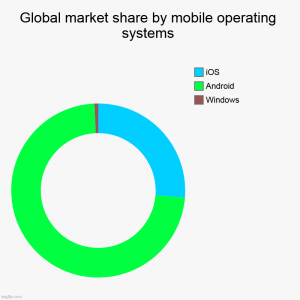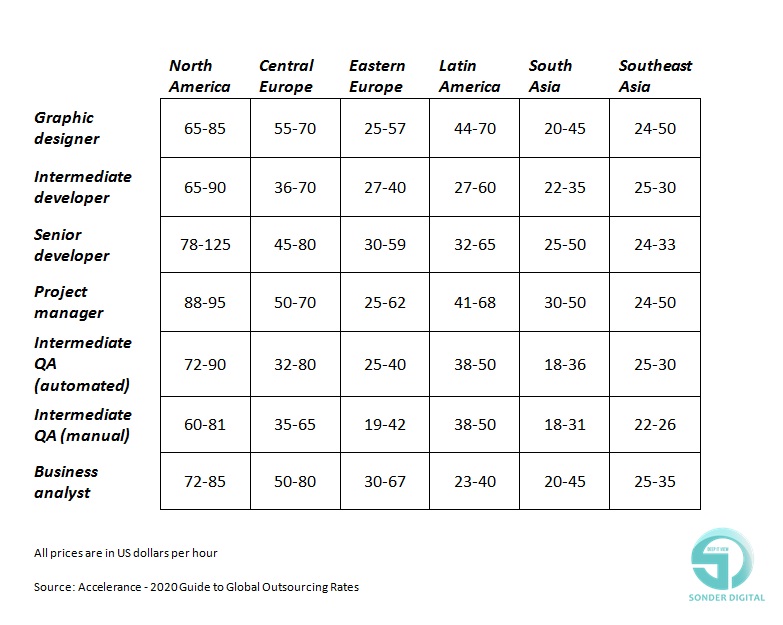Business process manager

How much does it cost to develop a mobile app? This is a fundamentally wrong question. It’s the same as asking how much a car costs. It‘s possible to answer the question, but it won‘t be useful. In other words, in order to provide meaningful information, one needs to know what brand of a car it is, when it was manufactured, what its configuration, etc.
As in cars, an information technology (IT) project (mobile application development is one of the possible IT projects) depends on the configuration. In the case of applications, the set corresponds to the number of functions you want to install in the application.
The purpose of this article is to help you better understand how much it can cost to build a mobile app and what that cost depends on. To understand the cost, you need to understand the application development process itself.
- Discovery
- Design
- Application programming
- Server side (back-end) development
- Project management
- Quality Assurance (QA)
- Hosting applications in Google and Apple stores
- Project support
- Marketing
- Team
- Summary
DISCOVERY
The development of a mobile application begins with refining exactly what you want to create. In another way, this can be called primary requirements definition phase. This is the very first point that will be important for any IT company to provide preliminary time and financial calculations.
Mobile application development companies during this phase can:
- carry out market research – to find out potential competitors of the client and similar apps in the market;
- analyse whether the mobile application is the best solution for the customer to achieve their goals;
- create visual prototypes;
- plan the stages and deadlines of application development.
Based on our experience, primary requirements definition phase can cost up to $2,000 or even more. However, many companies do this work (or part of it) for free in order to contract with a client. Larger companies usually charge for this service to make sure customers meets their responsibilities. Of course, even large application development companies are likely to be willing to take this step for free if they recognize the potential of the client. For example, if you represent a very large and well-known brand.
Approximately how long can this stage take? It would probably take about 24-30 working hours to work non-stop, but in practice this is almost never the case and these hours are spread over a longer period of time. Furthermore, many questions arise planning larger projects and it takes time to get answers from bigger companies and its various departments such as sales, marketing, management and other stakeholders. So this can take a month or even longer in real life. There have been cases in our practice where this stage took a couple of months.
DESIGN
The next step in setting an app development price is design. There are three possible paths here.
If the client has their own designer, there will usually be no problem if he develops the design for the mobile application. In this case, most likely, the client already pays a constant salary to the designer.
The second option is to hire a specialized design services company to prepare the design. In this case, the price calculation is simple: the work estimate in hours is multiplied by the price per hour. It usually takes about 40-60 hours to design a medium-sized mobile application. If we assume that a designer hour in our region costs around $35-50 (it can cost much more or much less, depending on the size of the company and other factors, etc.), it will cost around $1,750-2,500 to design.
The third and probably easiest option is to do everything with one service provider. Most mobile application development companies can also offer designer services. This option, in our opinion, is the best because a designer who has prepared a number of designs for a mobile application is well aware of all the important factors and knows how to prepare a design to match “Google“ (for devices with “Android“ operating system) and “Apple“ (for devices with an iOS operating system) store requirements. The price can range between $1,750 and 2,500 depending on the project complexity. Larger projects with different windows will cost more than smaller ones. The most expensive design is for game-type applications – range between $18,000 and 25,000 and more.

* Do you need to develop design separately for each platform (iOS and Android)? No, the design for both platforms is developed at once. The only thing that sometimes needs to be slightly adapted is the requirements of “Google“ and “Apple“ mobile app stores.
MOBILE APPLICATION PROGRAMMING
There are several possible options at this stage.
1. What programming tools / languages will be used?
In other words, whether the app will be developed in programming languages specifically for that operating system (also known as native (iOS-Swift, Android-Kotlin), or on a cross-platform basis (e.g. using Flutter).The native path is usually more suitable for complex and large projects where flawless operation is required. The cross-platform path is more suitable for simpler, smaller projects. Of course, each project is unique and the answer to which path to go, native or cross-platform is possible only after getting acquainted with the requirements of the project.
If you want to know which technologies are best to use in your project – contact us.
* In the context of this article, we calculate working hours on a so-called native basis.
2. For which operating systems will the project be developed (iOS, Android, Windows Phone)?
Based on our practice, most applications are developed for iOS and Android platforms. Windows Phone as mobile devices running this operating system account for less than 1% of all devices on the market so we do not use this system.

So let’s say the app will be for iOS and Android platforms. The exact price depends on developed application features. We need to know what functions we will create to be able to evaluate time needed for each. At the end estimated time and hourly rate are multiplied.
Below is a list of the most common features and the time it takes to build these features on any one platform (iOS or Android).
- Login via email (register, remind the password, log-out): 20-28 working hours;
- My profile (information, region, photo): 16-24 working hours;
- Search (basic search when offers are displayed): 16-20 working hours;
- Map (via Google Maps with objects, legend): 16 working hours;
- Shopping cart (for e-commerce applications): 24-30 working hours;
- History and details of orders: 24-32 working hours;
- Payments (PayPal or Stripe): from 32 working hours;
- Interviews (text format): 24-40 working hours;
- About the company and contacts: 6-8 working hours;
- News (depending on design and content): 16-24 working hours;
- Push notifications: from 10 working hours;
- Analytics: from 2 working hours.
- Simple application programming for one platform (iOS or Android): 120-180 working hours ($4,800-7,200).
- Medium-complexity application programming for one platform (iOS or Android): 280-400 working hours ($11,200-16,000).
- Programming a complex solution for one platform (iOS or Android): 500 hours and more (from $20,000).
*The average price for mobile application programming in Lithuania is $35-50 per hour. Calculations above are made at an average rate of $40 per hour.
SERVER SIDE (BACK-END) DEVELOPMENT
How to understand what the back-end is? By analogy with the iceberg, the part that rises above the water is the part that is visible to end users when using the application. The part that is underwater is the inner part (back-end). Its end user does not see.
There are usually three possible scenarios at this point:
1) the back-end part is not needed at all;
2) the back-end already exists;
3) this part is created from scratch.
If the back-end part is not needed at all the application is so simple that it just doesn’t need this part. Examples of such apps are a calculator, a voice recorder, various notebooks, a heart rate monitor, various apps for one-time events, etc.
If the back-end part already exists, you usually need to create an API (application programming interface). Generally speaking, an API is a chain that connects the back-end part (which the end user does not see) and the front-end (what the end user sees in the application).
How much can it cost? According to our experience, it takes about 40-80 working hours to program an API. The time depends on how many functions needs to be taken from the back-end part and displayed in the application. Sometimes the client has their own programmers who can create the API needed for the mobile application. It is important that both the API development team and the mobile application development team discuss together exactly what is needed to ensure successful project implementation.
The last option is that the back-end part is created by the same company that also develops the mobile solution. In this situation, it is important to understand the complexity of the solution being developed. From our practice, it takes 50-80 hours to create a very simple back-end. A more complex back-end solution, e.g. The Proxima project we developed took 400-500 working hours. The project required the connection of a complex money management system using several different money management services (Stripe and Plaid). For even more complex projects, e.g. for a UBER application, back-end creation of the initial version can take 700-900+ working hours.
The hourly cost of programming the back-end part is usually $35-50
- Development of the simple project. Back-end: 50-80 working hours ($2,000-3200).
- Development of medium-complexity project. Back-end: 400-500 working hours ($16,000-20,000).
- Development of complex project. Back-end: 700-900 working hours ($28,000-36,000 and more).
*Do you need to create server part separately for each platform, iOS and Android? No, the server part runs on both platforms at the same time.
PROJECT MANAGEMENT
Project management or otherwise the work of a project manager usually accounts for about 10-20% of the programming time. To make it easier to understand, imagine that you want to create a small project. It will take 200 hours for iOS programming, another 200 hours for Android programming, and 100 hours for server-side (back-end) development. A total of 500 hours will be generated. Project management will take 50-100 hours. If you calculate that the project manager’s hour costs $35, you will get that the project management in this situation will be $1,750-3,500.
Do you need a project manager? Maybe you can do without it and save money? In short, a project manager is an adhesive that holds different parts of a project together. By acting in a coordinated way, these parts can achieve their goals.
Sometimes small companies do not count on the work of the project manager or do not exclude him when presenting the project evaluation. They simply provide a total hourly rate that already includes project management.
QUALITY ASSURANCE WORKS (QA)
Quality assurance (QA) rules are very similar to project management. QA typically accounts for about 10-25% of programming time. Taking the same example with a 500-hour project, it is estimated that QA needs 50-125 man-hours or $1,750-4,375. The calculation assumes a QA hour of $30.
What does a QA specialist do? Tests the mobile app and ensures that it is free of bugs that can later deter users. One very annoying thing that can happen is that the end user will download an already created mobile app from Apple or Google stores and come across malfunctioning app features. Due to such errors very important first users can be lost.
Sometimes, just like with project management work, companies include QA in the total hourly rate of project execution.
It is always important for the client to ask who will be responsible for project management and quality assurance. Comparing the hourly rate alone and not knowing the whole context can lead to a misconception about the prices of one company or another.
ADDING APPLICATIONS TO GOOGLE AND APPLE STORES
The last step that needs to be evaluated and included in the project price is the placement of the application in Apple and Google stores. If you do not place the application in these stores, potential users of your application will not be able to download it (with some exceptions) to their phones.
As far as we have come across, uploading to these stores is not charged separately. It is important to know that in order to host applications on behalf of your company you will need to purchase access to these stores. These accesses cost $99 in the Apple Store and $25 in the Google Store, respectively. It’s important to note that in the Apple Store, you’ll have to pay $99 a year, and Google’s fee is a one-time fee – you pay once for all.
PROJECT SUPPORT
The project has been created and uploaded to the appropriate stores. Another step that can lead to higher or lower costs is project support. It is important to mention that this is not the same as warranty service. Warranty service means that if something goes wrong after uploading the project to the store and the application does not work as originally intended, a self-respecting IT company should fix it at no extra charge.
Project support tasks typically include optimizing code, improving program stability and performance, maintaining the latest versions of the operating system, developing new features, and more.
Also, after collecting the first user reviews quite often, customers want to make some improvements to the application.
Our practice shows that these works usually represent 15-20% of the initial value of the project over the next 12-18 months. The bulk of it here is not the support for new versions of the operating system, but the development of new features.
MARKETING
The application has been created and uploaded to the appropriate stores. What’s next? How will customers find out that such an application exists? After all, there are millions of different apps in stores. There are two paths.
The first is when your brand is already well known, and the app you have created is not your whole business, but part of an existing business. Let’s say you’re an e-shop or a spa. In this case, the application is likely to act as an additional sales channel or as a solution that provides additional benefits to existing customers. You can advertise it both on your page and by offering it to customers who want to stay at your spa.
Another option is active advertising on social networks, in the application stores themselves, on television and other channels. In this case, the costs for marketing can be equal to or even significantly exceed those spent on building a mobile application. It all depends on the number of channels and investments.
But after all, the application itself can appear in Google or Apple stores and people will see it? It may, but the chances are low because the competition, whether your app can be categorized as social networking, gaming, business or any other category, is quite high. The market should be studied very well – whether similar projects have really been developed. And if not, maybe such a solution is not relevant at the moment? Don’t think we want to discourage you from developing a mobile app, we’ve been dealing with a variety of projects and situations in this business for over 8 years. We really don’t want to create a project by wasting a client’s resources just to make it one of the n + 1 already in place.
The key question is how much does it cost? This is probably the only question to which we cannot give an exact answer.
* What are we doing in this place? We develop a marketing strategy: where, through what channels, to whom it would be best to present your product. The development of such a strategy usually costs around $2,500 to $3,500.
TEAM
It is very important to choose right partners for your project development. You can hire a team from the same city or country or you can hire it from another city, country or even continent. What is the essential difference? If we look only in the financial context, then the price you pay for an hour, and at the same time for the whole project, will be a fundamental difference.
Although IT is more or less a global business, the different standard of living in different countries and the number of IT professionals determine what salary a specialist will receive in different countries. This dictates what hourly rates a company will be able to offer to its customer. It is certainly not the case that a company with an hourly rate of $150 will always produce a better product than one with an hourly rate of $50. Maybe just one of them is in the US and the other in Europe.
To make it easier to understand how much prices can vary, you can see below the rates for different professionals in different regions.

SUMMARY
As you can see now, developing a mobile application is a multi-step process. The price can fluctuate significantly. Based on our 10 years of experience working with different continents, countries and projects it would be possible to distinguish the main price ranges:
- Simple mobile application solution for one (iOS or Android) platform: up to $15,000 / 12,000€;
- Medium-complexity mobile application solution for one (iOS or Android) platform: $25,000 – 35,000 / 20,000 – 28,000€;
- Sophisticated integrated solution for one (iOS or Android) platform: from $40,000 / 33,000€.
If you have an idea for a mobile application, contact us directly here or at info@sonderdigital.group







